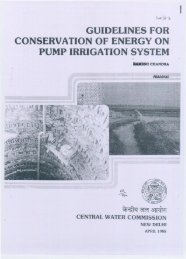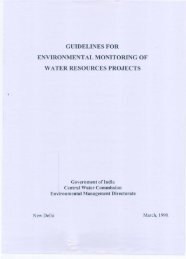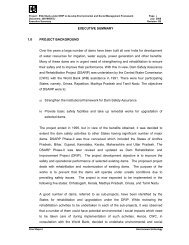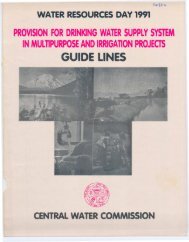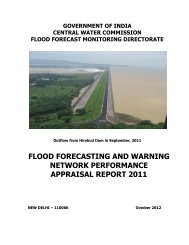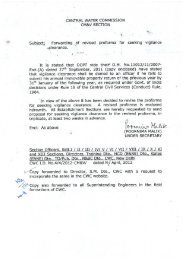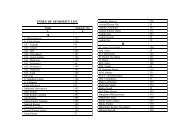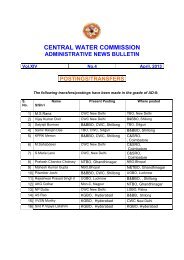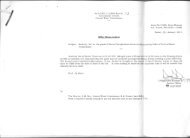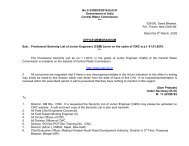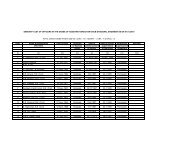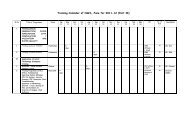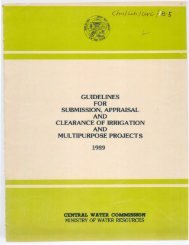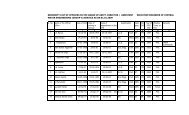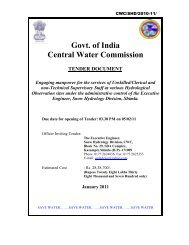Guidelines for Safety Inspection of Dams - Central Water Commission
Guidelines for Safety Inspection of Dams - Central Water Commission
Guidelines for Safety Inspection of Dams - Central Water Commission
Create successful ePaper yourself
Turn your PDF publications into a flip-book with our unique Google optimized e-Paper software.
Code<br />
No.<br />
I<br />
II<br />
Table III<br />
Minimum Desired Values <strong>of</strong> Factors <strong>of</strong> <strong>Safety</strong><br />
[as per Code IS 7894 <strong>of</strong> 1975]<br />
Loading<br />
Conditions<br />
Construction<br />
condition with or<br />
without partial<br />
pool. *<br />
Reservoir partial<br />
pool.<br />
Slope most<br />
likely to be<br />
critical<br />
Upstream &<br />
downstream<br />
Upstream<br />
Pore Pressure<br />
Assumption<br />
To be accounted <strong>for</strong><br />
the Hilf's method.<br />
Weights <strong>of</strong> material<br />
in all zones above<br />
phreatic line to be<br />
taken as moist and<br />
those below as<br />
buoyant.<br />
Type <strong>of</strong><br />
shear<br />
strength<br />
test to be<br />
adopted<br />
Minimum<br />
desired<br />
factor <strong>of</strong><br />
safety<br />
QR * 1.0<br />
RS +<br />
III Sudden drawdown<br />
Max.head water to<br />
(a) min.with tail water<br />
at max.<br />
Upstream As given in 5.4.2 ** RS +<br />
Max.tail water to<br />
(b) min. with reservoir<br />
full<br />
Downstream As given in 5.4.5 ** RS +<br />
IV<br />
Steady seepage<br />
with reservoir full<br />
Downstream As given in 5.5.2 ** RS +<br />
Steady seepage<br />
V with sustained<br />
rainfall<br />
Downstream As given in 5.6.1 ** RS +<br />
VI<br />
Earthquake<br />
condition:<br />
(a) Steady seepage Downstream As given in Case IV RS +<br />
(b) Reservoir full Upstream As given in Case II RS +<br />
1.3<br />
1.3<br />
1.3<br />
1.5<br />
1.3<br />
1.0 Ψ<br />
1.0 Ψ<br />
Note: These factors <strong>of</strong> safety are applicable <strong>for</strong> the method <strong>of</strong> analysis mentioned in the Code.<br />
* Where the reservoir is likely to be filled immediately after completion <strong>of</strong> dam, construction<br />
pore pressure would not have dissipated and these should be taken into consideration. This<br />
is to be adopted <strong>for</strong> failure planes passing through impervious foundation layer.<br />
+ S Test may be adopted only in cases where the material is cohesionless and free draining.<br />
Ψ Values are according to IS:1893-1984 “Criteria <strong>for</strong> earthquake resistant design <strong>of</strong><br />
structures (3 rd rev.).<br />
** These refer to the Code.<br />
Q Test = Unconsolidated undrained test<br />
R Test = Consolidated undrained test and<br />
S Test = Consolidated drained test.<br />
23



